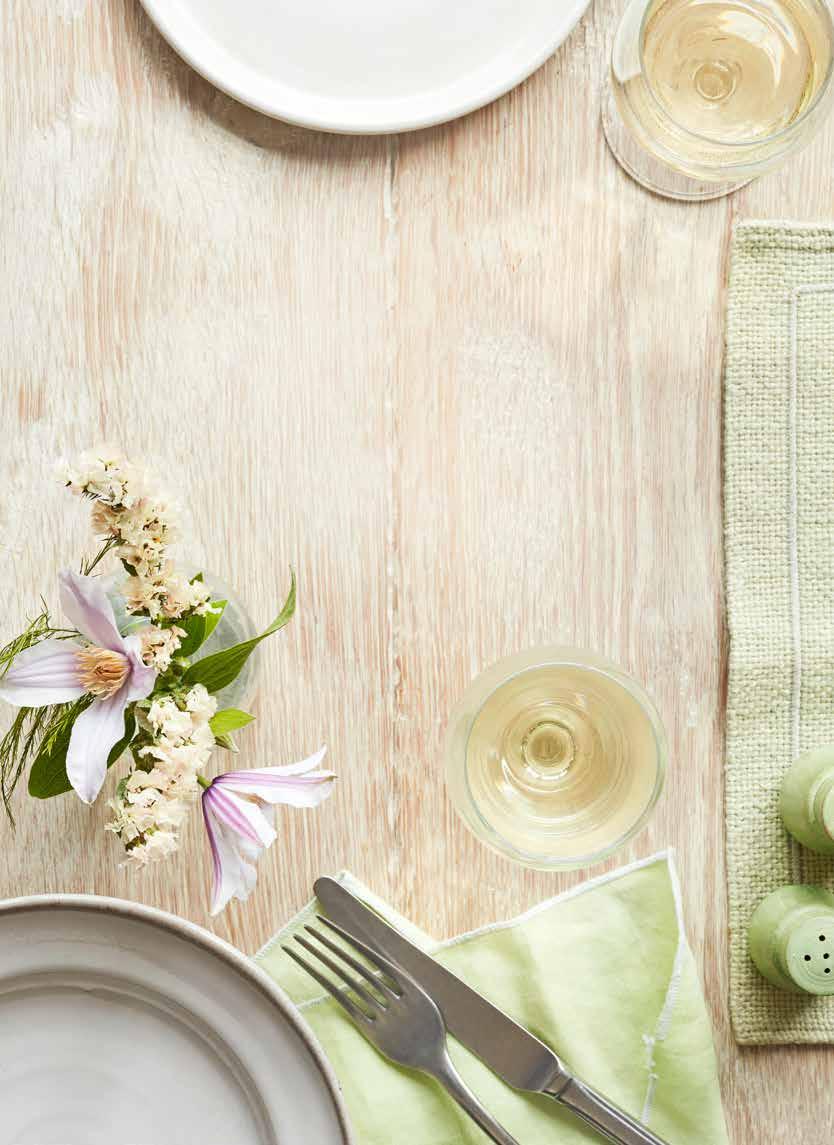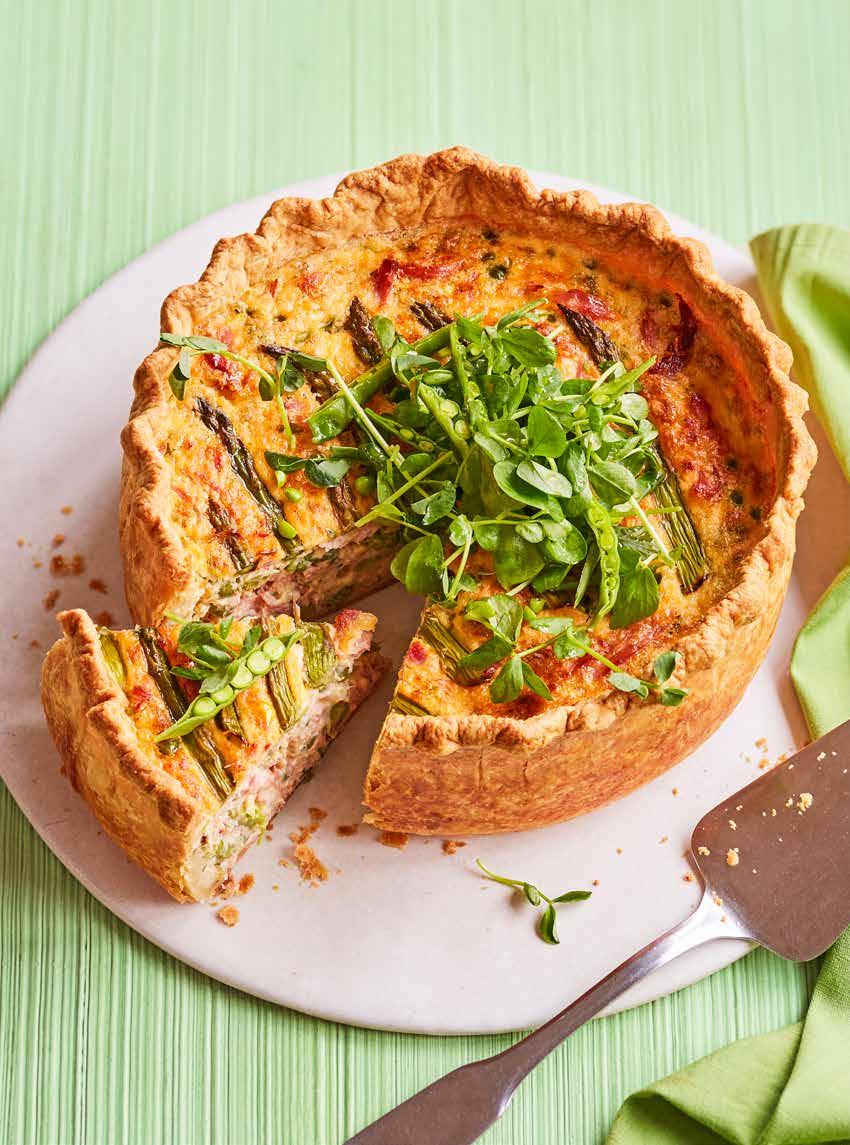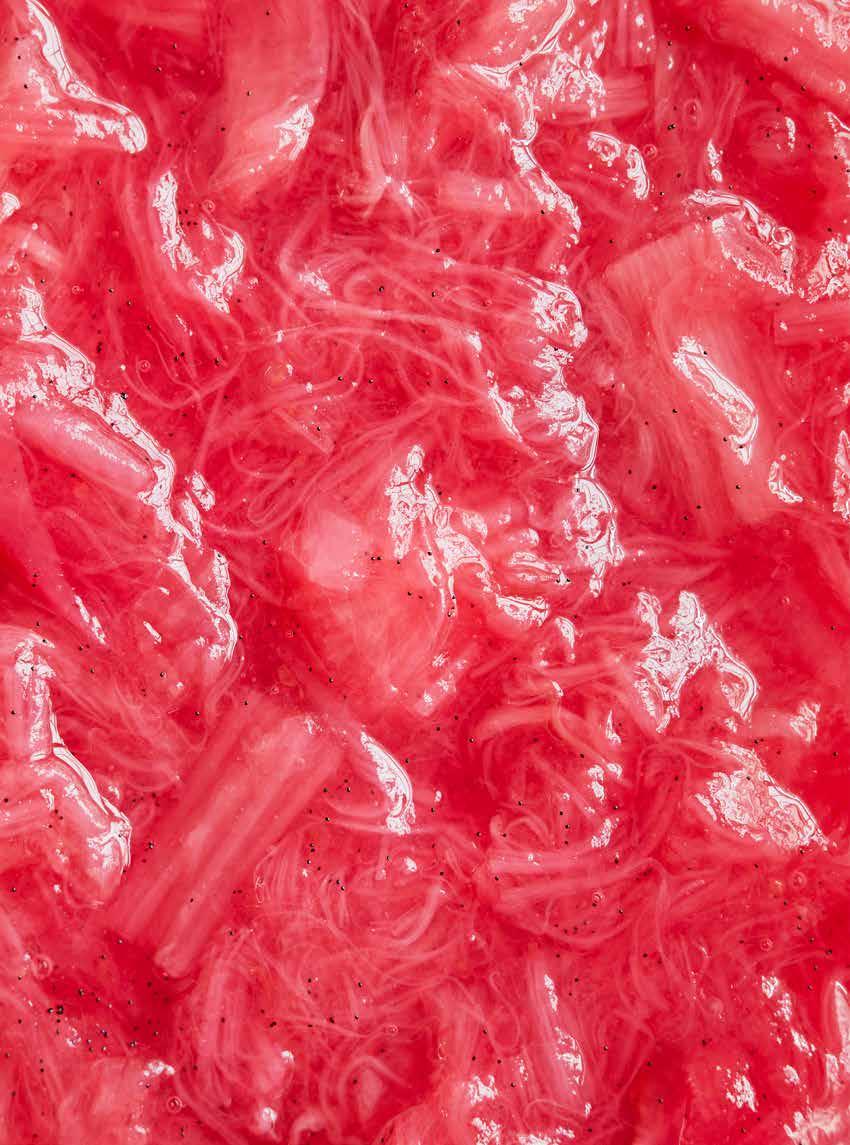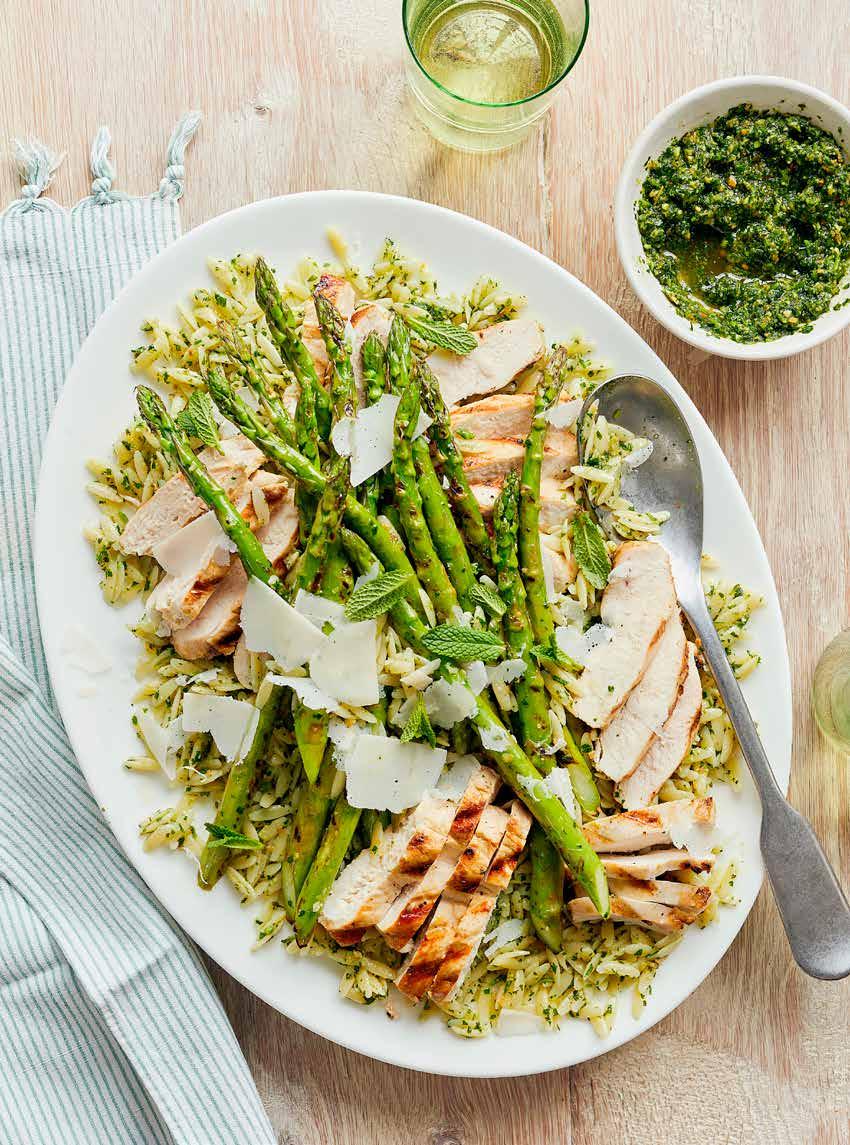
14 minute read
SUMMERTIME CELEBRATION
As the days become longer and warmer, now’s the time to bring friends and family together to share good food. With these recipes, the occasion will be even more memorable
recipes GOOD FOOD TEAM photographs JONATHAN GREGSON
Pea, asparagus & ham hock tart
Showcase the grassy sweetness of fresh peas and asparagus in a luxurious quiche, encased in golden, flaky pastry. The ham hock provides a savoury depth, while optional mustard powder adds a gentle kick of heat. Try it for a picnic or party spread.
SERVES 6-8 PREP 25 mins plus at least 1 hr 30 mins chilling COOK 1 hr 25 mins EASY P
200g fresh podded peas, or use frozen (defrosted) 8 asparagus spears, halved 4 eggs 200g double cream 200g crème fraîche handful of flat-leaf parsley or mint (or use a mixture), finely chopped 6 spring onions, finely chopped 1 lemon, zested and juiced 25g parmesan, finely grated 150g cooked ham hock, shredded For the pastry 250g plain flour 125g cold unsalted butter, cut into cubes 2 tsp mustard powder (optional) 30g parmesan, finely grated For the topping 25g pea shoots 50g mangetout, halved lengthways ½ tsp extra virgin olive oil

1 First, make the pastry. Rub the flour, butter, mustard powder (if using), parmesan and 1 tsp fine salt together in a large bowl using your fingertips until the mixture resembles sand. Or, do this by pulsing the ingredients together in a food processor. Gradually add 4-6 tbsp cold water, pressing the mixture together until you have a soft dough. Briefly knead the dough until smooth. 2 Roll the pastry out between two sheets of baking parchment until 3mm thick and large enough to line a 20 x 7cm loose-bottomed springform cake tin. Remove the top layer of parchment and invert the pastry into the tin, or drape it over the rolling pin and unravel it into the tin. Push the pastry into the base and up the side – there should be about 11/2 cm excess pastry that comes above the rim. Use your thumbs and index finger to crimp the excess around the edge. Chill for at least 1 hr 30 mins or overnight. 3 Meanwhile, cook the peas and asparagus in a pan of boiling water for 3 mins, or just 2 mins for defrosted frozen peas. Immediately plunge into a bowl of ice-cold water to halt the cooking process, and leave to cool in the bowl for 2 mins. Drain and set aside until needed. 4 Heat the oven to 200C/180C fan/ gas 6. Prick the base of the chilled pastry case all over with a fork. Scrunch up a piece of baking parchment, then use it to line the case, leaving some overhanging. Fill the case all the way to the top with baking beans or uncooked dry beans or rice. Bake for 15 mins, then remove the beans and parchment and bake for 10-15 mins more until golden. Don’t worry if it shrinks from the edge slightly. Leave to cool while you make the filling. 5 Whisk together the eggs, double cream and crème fraîche, then mix in the herbs, spring onions, lemon zest and juice, parmesan and cooked peas. Season with sea salt and a good crack of black pepper, then pour the filling into the baked case. Sprinkle the shredded ham hock over, pressing it into the filling slightly, then arrange the asparagus spears on top. 6 Turn the oven down to 190C/ 170C fan/gas 5 and bake the quiche for 45-55 mins until golden on top with a slight wobble in the middle. Leave to cool for 20 mins in the tin, then serve warm or leave to cool completely and chill until needed. Will keep chilled for three days. 7 When ready to serve, toss the pea shoots and mangetout with the olive oil, then pile in the middle of the quiche. Cut into wedges to serve.
PER SERVING (8) 570 kcals • fat 43g • saturates 26g • carbs 28g • sugars 2g • fibre 3g • protein 16g • salt 1.4g
PASTRY TIPS
• Chilling the pastry before baking reduces the chance of it shrinking in the tin. If you like, you can chill it in the freezer for 20 mins to speed up this process. • We’ve rolled the pastry out between two sheets of baking parchment because this means you won’t need to add flour to prevent it sticking – this can alter the texture. • Fill the pastry case all the way to the top with baking beans to help keep the pastry from shrinking in the oven. • ‘Docking’, or pricking the base of the pastry case with a fork, ensures it bakes evenly and doesn’t rise. • Use a small offcut of pastry to push the pastry into the base of the tin. This helps prevent tearing.

Rhubarb & custard scones
These light and fluffy scones bring together one of Britain’s best-loved flavour combinations: rhubarb and custard. They make a nostalgic treat alongside a bowl of clotted cream and punnet of strawberries for an afternoon tea in the garden.
MAKES 6 PREP 20 mins plus chilling COOK 22 mins MORE EFFORT V
300g self-raising flour, plus extra for dusting 50g custard powder 1 tsp baking powder 50g caster sugar 95g cold unsalted butter, cut into cubes 150-175ml whole milk 1 egg, beaten clotted cream, to serve For the rhubarb compote 250g rhubarb, roughly chopped (or use chopped frozen rhubarb) 100g caster or granulated sugar 1 lemon, zested ½ tsp vanilla bean paste drop of red food colouring gel (optional)

1 Mix the flour, custard powder, 1/4 tsp fine salt, the baking powder and sugar together in a large bowl. Rub the butter into the dry ingredients using your fingertips until the mixture resembles fine breadcrumbs. 2 Gradually mix in the milk using your hands until you have a smooth dough – you may not need it all. Gently roll the dough out on a lightly floured surface to a 2cm thickness. Transfer to a baking tray lined with baking parchment, cover and chill for 30 mins to firm up, or up to 1 hr if you want to get ahead. 3 Meanwhile, make the rhubarb compote. Tip all the ingredients into a large saucepan along with 2 tbsp water (omit the water if you’re using frozen rhubarb). Simmer over a medium heat for 10-15 mins, stirring occasionally until the rhubarb has softened and is almost collapsing, and the mixture has thickened. If you’re using frozen rhubarb, you may like to stir in a drop of red food colouring to enhance the pink colour. Transfer the compote to a bowl and leave to cool completely. 4 Heat the oven to 220C/200C fan/ gas 7 and remove the dough from the fridge. Line a baking tray with baking parchment. Stamp out three or four scones from the dough using a 7cm round biscuit cutter (see tip below). Arrange the scones on the prepared tray, leaving a 2cm gap between each. 5 Roll the remaining dough out again as in step two, then stamp out as many scones as you can (you should get about six in total). Transfer these to the tray as well, then brush all the scones with the beaten egg (see tip below). Bake for 10-12 mins until the tops are golden brown, then leave to cool completely on the tray. Serve with the rhubarb compote and clotted cream. Best eaten the day they’re made.
GOOD TO KNOW calcium PER SERVING 465 kcals • fat 16g • saturates 9g • carbs 72g • sugars 27g • fibre 3g • protein 7g • salt 1g
tip
Be careful not to twist the biscuit cutter when stamping out the scones. If you do, they may not rise evenly. This can also happen if the beaten egg drips down the sides when you brush it over the tops.

Chicken pesto orzo salad
Elevate standard pasta salad by using orzo and pesto. This recipe also offers a good way to make the most of asparagus while it’s in season, too – it adds flavour, texture and colour.
SERVES 4-6 PREP 25 mins COOK 15 mins EASY
2 boneless, skinless chicken breasts 1 lemon, zested and juiced 3 garlic cloves, 2 crushed, 1 left whole 1 tbsp olive oil 25g flaked almonds large bunch of flat-leaf parsley small bunch of basil small bunch of mint, leaves picked 25g parmesan, grated, plus extra shaved parmesan to serve 100ml extra virgin olive oil, plus a drizzle to serve 250g orzo 16 asparagus spears
1 Put the chicken breasts on a board and cover with a sheet of baking parchment. Use a rolling pin or meat mallet to bash to an even thickness of about 2cm, being careful not to break the chicken into pieces. 2 Combine the lemon zest, crushed garlic, olive oil and some seasoning in a medium bowl, then add the chicken and turn in the marinade to coat. Transfer to the fridge while you make the pesto. 3 Toast the flaked almonds in a dry frying pan over a medium heat for 2-3 mins, shaking the pan often until the almonds are golden brown. Tip into a small food processor or blender. Peel the whole garlic clove and tip this into the food processor along with the parsley, basil, most of the mint leaves, the parmesan, extra virgin olive oil and lemon juice. Season, then blitz to a fine texture. 4 Cook the orzo in a large pan of boiling salted water following pack instructions, or until al dente. Heat a griddle pan over a medium-high heat and cook the marinated chicken for 4-5 mins on each side until cooked through with char lines. Drain the orzo and transfer the chicken to a plate to rest. 5 Drizzle the asparagus spears with a little extra virgin olive oil and season with salt, then griddle for 3 mins until just softened. Remove from the heat and set aside. 6 Toss most of the pesto through the cooked orzo along with any resting juices from the chicken. The remaining pesto will keep covered in the fridge for up to five days. Slice the chicken breasts. Tip the orzo onto a large serving platter and pile the asparagus and chicken on top, then scatter with the remaining mint leaves, some parmesan shavings and a grinding of black pepper. Drizzle with a little extra virgin olive oil and serve warm.

GOOD TO KNOW vit c PER SERVING (6) 461 kcals • fat 25g • saturates 4g • carbs 33g • sugars 2g • fibre 3g • protein 25g • salt 0.2g

We’ve butterflied the salmon so the watercress sauce runs through each slice, which ensures it’s succulent. But, you could also simply spread the sauce over the salmon. For easier clean-up, line the roasting tin with baking parchment – this helps the parmesan stick to the potatoes rather than the pan.
SERVES 5 PREP 25 mins COOK 1 hr MORE EFFORT
100g watercress, plus a few sprigs to serve 180g soft cheese 1/2 lemon, zested and juiced 2 tsp Dijon mustard or horseradish sauce 700g whole salmon fillet, skin on 1/2 tbsp olive oil For the potatoes 1kg new potatoes, halved or quartered if large 11/2 tbsp olive oil 50g parmesan, finely grated small bunch of thyme, finely chopped
1 Heat the oven to 230C/210C fan/ gas 8 and line a large, shallow roasting tin with baking parchment. Tip the potatoes into a large bowl and drizzle with the olive oil, then toss well to coat. Sprinkle over the parmesan, thyme and seasoning, then toss again to cover. Tip the potatoes into the tin and spread out in an even layer. Roast for 40 mins, turning after 30 mins, until golden and just cooked through. 2 Meanwhile, roughly chop the watercress and tip into a food processor or mini chopper along with the soft cheese, lemon zest and juice, the Dijon mustard or horseradish sauce and plenty of seasoning. Blitz until you have a thick, bright green sauce. Scrape into a bowl and set aside. Will keep covered in the fridge for up to a day. 3 Lay the salmon out on a board, skin-side down. With your hand positioned flat on top of the fillet, carefully use a long, sharp knife to slice into it from the side, being careful not to cut straight through. Open the fillet out like a book, then spread over half the sauce to cover the surface completely. Close the fillet again to enclose the sauce. Set aside until the potatoes are ready. 4 After 40 mins, toss the potatoes again and push them to the sides of the tin, leaving space in the middle for the salmon. Nestle the salmon into the middle of the potatoes, skin-side down. Drizzle with the olive oil and roast for 15-20 mins until the salmon is just cooked through. Serve straight from the tray with a few sprigs of fresh watercress scattered over and the remaining watercress sauce on the side for drizzling.

GOOD TO KNOW calcium • vit c • omega-3 • gluten free PER SERVING 605 kcals • fat 34g • saturates 12g • carbs 33g • sugars 4g • fibre 5g • protein 39g • salt 0.8g
TWIST IT
One-pan wild-garlic-stuffed salmon with parmesan new potatoes
The watercress in this recipe can be swapped out for 100g raw wild garlic leaves (ensure they’re washed well to remove any dirt and grit). If you also have the wild garlic stems, separate them from the leaves and slice as you would chives for sprinkling over at the end. If you have wild garlic flowers, they make a beautiful garnish, too. Or for the best of both, opt for half wild garlic and half watercress.

Lemon & elderflower traybake
This fresh twist on the classic bakewell has a delicate floral aroma and flavour, making it ideal for serving at pool parties or bake sales.
SERVES 12-15 PREP 40 mins plus chilling and cooling COOK 1 hr 10 mins MORE EFFORT V
250g lemon curd, plus extra to decorate 250g butter, softened 250g caster sugar 2 lemons, zested 4 eggs 100g self-raising flour 150g ground almonds For the pastry 200g plain flour, plus extra for dusting 125g cold unsalted butter, cut into cubes 1 tbsp caster sugar 1 lemon, zested 1 egg yolk For the icing 200g icing sugar 2 lemons, juiced (use the zested lemons above) 2 tbsp elderflower cordial

1 First, make the pastry. Tip the flour, butter, sugar and lemon zest into a food processor and blitz until the mixture resembles fine breadcrumbs. Tip in the egg yolk and 1/2-1 tbsp cold water and blitz again to bring everything together into a dough. If the dough isn’t coming together, add more cold water, 1/2 tsp at a time, and blitz again. Roll the pastry out on a lightly floured surface to a 3mm thickness, then use it to line the base of a loose-bottomed traybake or brownie tin (ours was 20 x 30cm). Transfer to the fridge and chill for 20 mins. 2 Heat the oven to 200C/180C fan/ gas 6. Line the chilled pastry case with baking parchment and baking beans, then bake for 15 mins. Remove the parchment and beans and bake for 5 mins more until the pastry is lightly golden. Leave to cool for a few minutes before spreading over the lemon curd, leaving a 2cm border around the edges (it will spread out when the cake batter is poured over). Turn the oven down to 180C/160C fan/gas 4. 3 Beat the butter, sugar and lemon zest together using an electric whisk or in a stand mixter until pale, light and fluffy, about 8 mins. Beat in the eggs, one at a time along with 1 tbsp of the flour, then fold in the remaining flour and the ground almonds. Carefully spoon the batter over the lemon curd and gently spread out using the back of the spoon, then bake for 35-40 mins until a skewer inserted into the middle comes out clean. Leave to cool in the tin completely, then carefully remove to a board. 4 To make the icing, combine the icing sugar, lemon juice and elderflower cordial until loose enough to drizzle over the sponge, then swirl over extra lemon curd, if you like. Cut into squares and serve. Will keep in an airtight tin for up to three days.
PER SERVING (15) 518 kcals • fat 29g • saturates 14g • carbs 57g • sugars 41g • fibre 1g • protein 7g • salt 0.6g
TWIST IT
• Orange & ginger traybake Swap the lemon zest and lemon curd for the same amounts of orange zest and marmalade, then use ginger cordial in place of the elderflower. • Lime & passion fruit
traybake
Use the same amounts of lime zest and lime curd instead of lemon, then make a passion fruit drizzle using the seeds of 4 passion fruit, the juice of 1 lime and just enough icing sugar to make a pourable icing.











